This is the third of four parts of the Indeed Tech Skills Explorer – an interactive look at which tech skills are in demand and which tech jobs are using those skills. This report looks at the major trends in the tech skills market. For these reports, we searched for more than 500 tech skills in US postings for tech jobs on Indeed.com.
Key points:
- The constant innovation in JavaScript web development frameworks is evident in the rise and fall of skills like Backbone.js, Angular.js, React.js, and Vue.js.
- Docker, Kubertnetes, and other containerized tech tools have exploded in use as cloud computing has soared.
- Spark, Hadoop, and other Big Data tools are also gaining steam as employers look for workers who can work with enormous data sets.
The tech skills landscape is vast. In a previous report, we looked at the popularity of over 500 tech skills in the US since 2014. We covered today’s leading tech skills — SQL, Java, and Python top the list. In another post, we focused on the skills with meteoric spikes and catastrophic drops in popularity. But it’s easy to get lost in the details of tech skill ups and downs. In reality, tech workers have suites of skills and groups of skills rise or fall based on bigger trends in the digital world.
So what are those big picture trends shaking up tech skills today? We highlight three overarching developments that are reshaping the tech universe:
- dynamic innovation in JavaScript web development
- explosive growth in containerization and cloud computing tools
- specialized skills for Big Data processing.
JavaScript innovation
Front end web development has been evolving rapidly. Seemingly every year, a hot new JavaScript framework revolutionizes old ways of creating web applications. This is technology at its best — superior upstarts replacing staid incumbents. But it can be frustrating for both tech job seekers and employers alike, especially for front end developers who strive to make web applications functional and attractive. So, what are the most popular JavaScript libraries and frameworks now? Which are poised to fade? And which are likely to carve out a niche and still be popular five years from now?
Angular remains on top as the most common JavaScript library, surpassing jQuery sometime in 2018. jQuery has fallen 30% in five years, but Ajax is down even more, 54%. React.js has soared over the past five years and shows no sign of letting up. It recently passed jQuery as the second most popular JavaScript library. Node.js has grown steadily in popularity. Further down the list, a remarkable shift away from Backbone.js has slashed its appearance in job postings 47% since 2014.
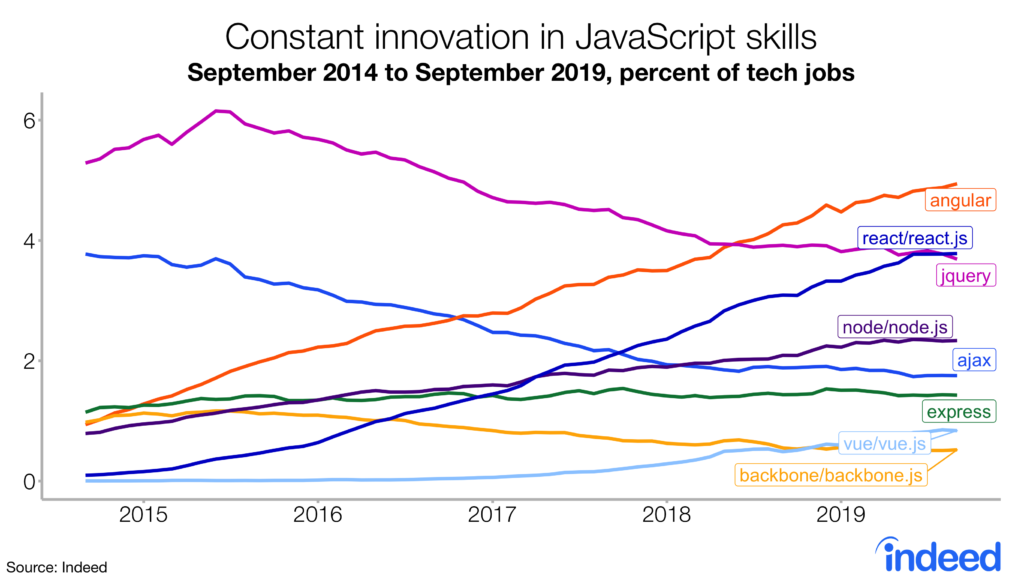
The past year has seen dynamic changes in the relative rankings of JavaScript tools. Upstart framework vue.js is up tremendously — 72% in the 12 months ending September 2019. And by far the fastest-growing JavaScript framework, vue.js might be poised for more explosive growth in the years to come. Web development is constantly changing and it’s extremely difficult to predict which currently popular technologies will hang around and which will fade away.
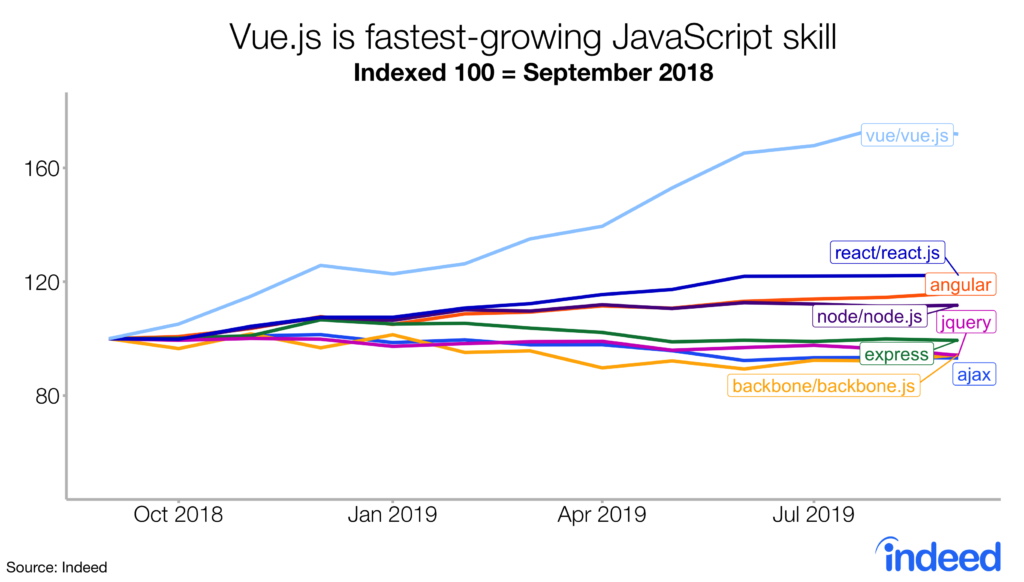
Cloud computing and containerization
Docker, Kubertnetes, and other containerized tech tools allow software engineers to isolate the environment in which an application runs, permitting rapid scalability as user traffic grows. Employers increasingly demand these skills. As noted in an earlier post, Docker was far and away the fastest-growing tech skill in the five years through September 2019. The rise of Kubernetes is more recent. Kubernetes was the most widely used tool in the list of skills that rose the fastest in the year ending September 2019, ranking ninth.
As with containerization tools, cloud computing products like Amazon Web Service (AWS) and Azure have also skyrocketed. AWS is now the sixth overall tech skill and Azure is 17th. In just a few years, cloud computing has moved from a cutting-edge skillset to a standard and widespread part of the workflow for many tech employees.
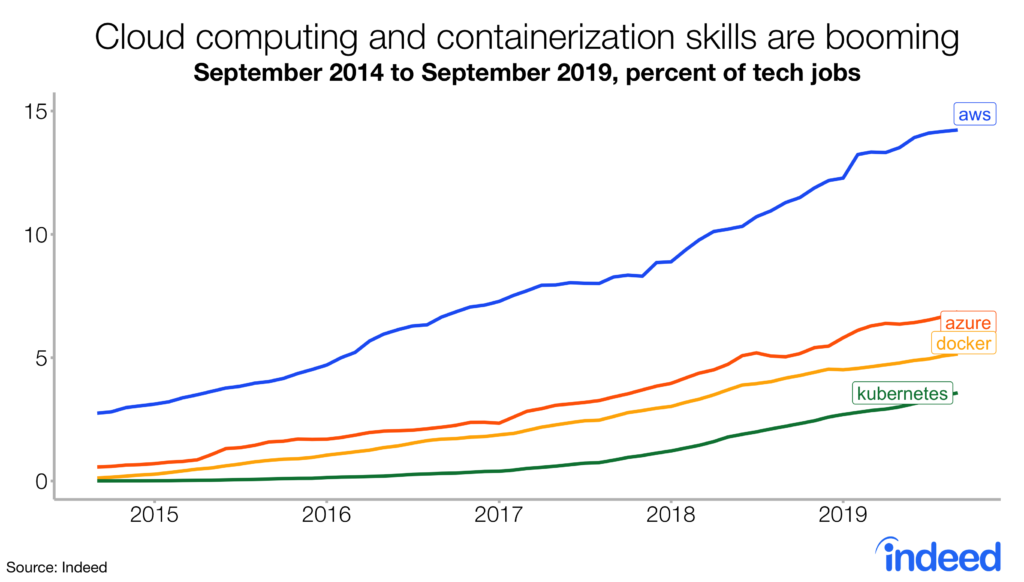
Data science goes big
There are a plethora of Big Data tech tools that allow data scientists and engineers to work with massive data sets. These tools typically provide either computational power spread across multiple computer clusters or the cloud, or a predictive modeling apparatus that uses machine learning, deep learning, neural networks, or various other statistical techniques.
Big Data processing tools like Redshift, Spark, and Google’s machine learning library Tensorflow have soared. Spark’s growth is particularly stunning, up more than 10-fold since 2014. As data science becomes a proportionally bigger part of the tech job landscape, programming languages tailored for this discipline, notably Python and the statistical programming language R, grow in popularity too. R more than doubled in the five years through September 2019, growing 6% in the past year alone. Python is up 123% over the five-year period and 12% in the past year.
The proprietary data analysis software Tableau has grown remarkably for a non-open source tool. Most other proprietary analytical tools, such as Matlab and Sas are flat or declining. Stata (not shown in figure) is another proprietary statistical tool, but it’s up 40% over 5 years, albeit from an extremely low base. Python is not included in the figure because its scale is so much bigger — it’s the third-ranking tech skill overall — and is not strictly a data science tool.
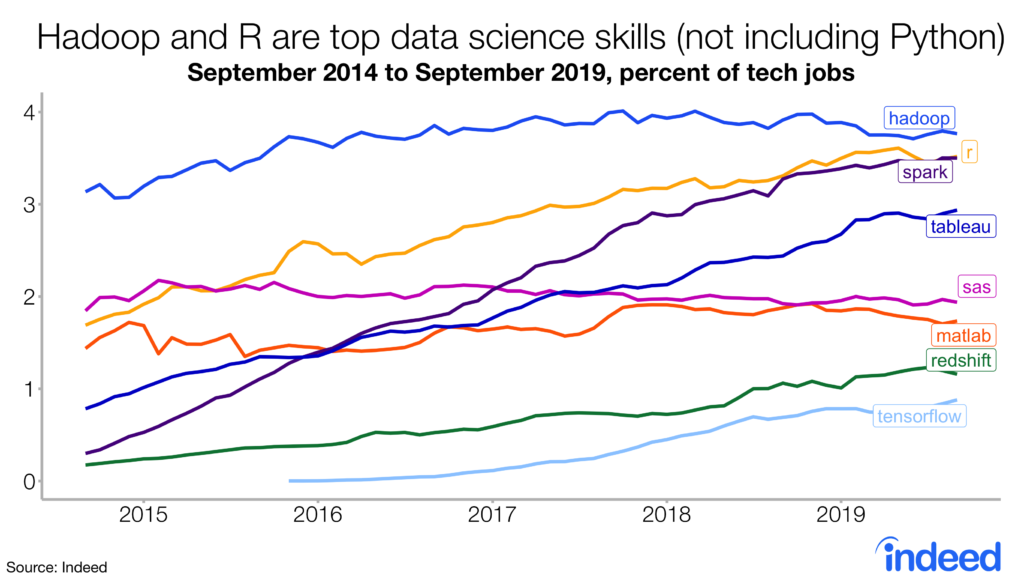
But data science is not just about software tools. Data scientists must also master important statistical and mathematical methods to effectively perform such functions as creating predictive models of consumers, forecasting sales, and recommending movies to watch, items to purchase, or people to follow. Thus, data science disciplines, such as machine learning and artificial intelligence, are among the fastest-growing tech skills appearing in Indeed job postings.
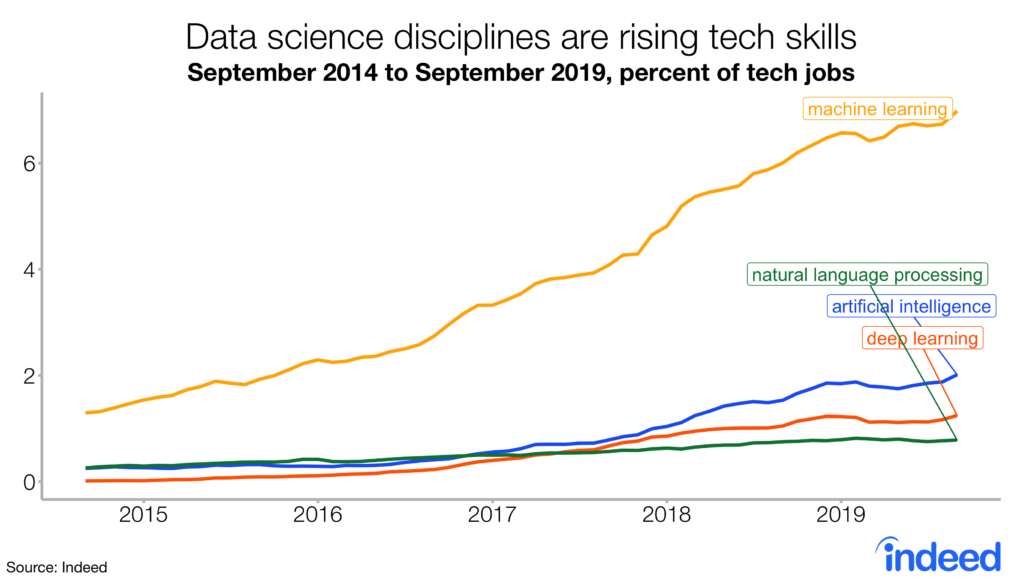
Conclusion
These three big-picture tech skill trends — rapid innovation in web development; surging demand for cloud computing and containerization skills; and data science software tools and disciplines designed to capitalize on the explosion of information — represent the leading edge of the always rapidly evolving tech sector. So then, what are the top skills needed for specific tech jobs? Stay tuned for our fourth tech skills installment to find out.
Methodology
We use a list of over 500 tech skill terms to query the job descriptions of postings on Indeed.com between September 2014 and September 2019. Only US English language postings having one of these tech job titles were considered. One cautionary note: Multiple skills can appear in the same job description and some terms can appear in multiple distinct skills, like “SQL” and “SQL server.”






